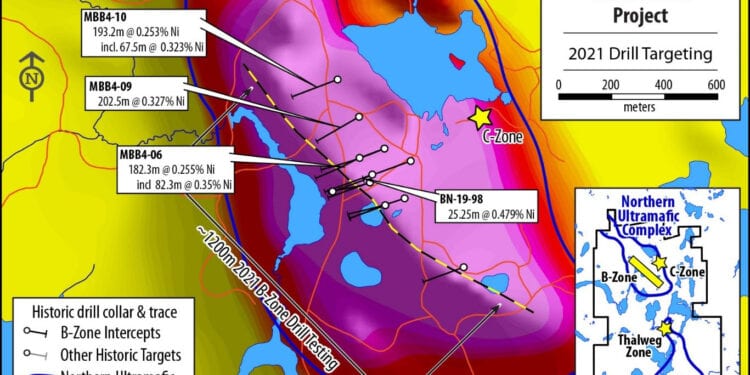Chasing Bulk Nickel Tonnage In Ontario
Grid Metals Corp.(TSXV:GRDM) has commenced drilling at its 100% owned Bannockburn Nickel Sulphide Property in the Matachewan area of north-eastern Ontario.
Vice President of Exploration and Business Development, Dr Dave Peck, said the focus of the drill programme will be bulk tonnage disseminated nickel sulphide mineralisation hosted by a three-kilometre-long serpentinised ultramafic body.
The company plans to drill up to 10 holes and 2,500m along a one kilometre section of the B Zone trend of disseminated nickel sulphide mineralisation.The new holes will be used to:
- Better constrain the average nickel grade, thickness and lateral continuity of the B Zone to vertical depths of approximately 200m;
- Provide an initial indication of the depth extent of an interpreted higher-grade core within the B Zone; and,
- Provide material for a composite sample for a new metallurgical study that will investigate nickel deportment, recoveries and potential concentrate grades.
One of the previous Grid drill holes assayed 0.327% nickel over a core length of 202m, which compares favourably with recent drilling results Canada Nickel Company’s Crawford nickel deposit (High Grade Zone).
A previous metallurgical programme on a composite sample from the B Zone found that 70% of the nickel in the sample reported to heazlewoodite, a secondary nickel sulphide mineral that contains 74% nickel and offers the potential to produce a very high nickel concentrate grade.
The programme at Bannockburn has been designed to specifically address the following economic targets:
- The potential for a near surface, large tonnage nickel sulphide resource in excess of 100 million tonnes containing over 200 kilotonnes of potentially recoverable nickel; and,
- The potential to produce a premium grade nickel concentrate in the range of 25-35% nickel through standard flotation processing.
The company’s economic model for the near surface part of the B Zone is analogous in terms of thickness, size and in situ metal value per tonne to large, low-grade gold mines and porphyry copper mines operating in Canada today.
Drilling is being guided by the results of a recently completed magnetic inversion model of an historical airborne magnetic survey. The new 3D magnetic model clearly defined a central magnetic peak within the serpentinised ultramafic body that hosts the B Zone. This magnetic peak is spatially associated with the highest nickel grades in the B Zone to date and likely reflects areas of maximum intensity of serpentinisation, secondary magnetite development and secondary nickel sulphide mineralisation.
The company is also creating a new 3D magnetic model for a four-kilometre-long magnetic anomaly (Southern Ultramafic Target) that occurs to the south of the B Zone. The Southern Ultramafic Target hosts local massive sulphides referred to as the Thalweg Zone. The massive sulphides in the Thalweg Zone occur at the northern end of the Southern Ultramafic Target and include maximum grades of 4.0% nickel and 0.17% cobalt over a one metre core length (in hole MBF4-04) as described in the current Technical Report for the Property.
Dr Peck said that with success in the current drill programme the company will consider new drilling on the Southern Ultramafic Target including:
- Additional holes in the Thalweg Zone target area where previous geophysical surveys identified several high conductance anomalies that have yet to be drilled; and,
- Exploring for additional B Zone-style mineralization in the previously untested central and southern parts of this large magnetic feature.
“We see a unique opportunity at Bannockburn to discover large tonnage disseminated nickel sulphide resources potentially amenable to open pit mining and having the ability to deliver a superior grade nickel concentrate,” Dr Peck said.
“We will also be exploring for a higher-grade core in the B Zone that could potentially be extracted via bulk underground mining methods, and for smaller tonnage but high-value massive nickel sulphide deposits that could provide critical early value for any future mining operations.
“The known ultramafic complexes on the property have the necessary scale to host a major new nickel sulphide resource. The project is extremely well situated in the Timmins region of north-eastern Ontario with its established mining infrastructure and significant resources of renewal energy.”












